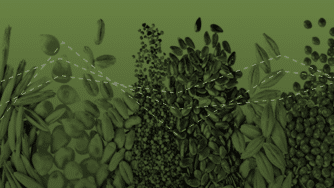By Sarah Mueller
Regardless of crop, farmers make many important decisions every year. They face dozens of questions from what crop and variety to plant, rate and type of fertilizer application, tillage, when to plant, and many more. For corn farmers, in particular, one of the most talked about decisions is nitrogen (N) fertilizer application.
Corn response to the timing, rate, and source of nitrogen fertilizer has been studied for decades, but each year more research is funded. Why is there so much emphasis on just one of the many decisions farmers make? Because it is an expensive input and there is still a lot of room for improvement.
Nitrogen is abundant in the air – it makes up 78% of our atmosphere – but plants like corn cannot use nitrogen present in the air. Instead, corn must use its roots to get the nitrogen it needs from the soil. The trouble is that nitrogen has very dynamic reactions with its environment and it can be difficult to “hold” nitrogen in the soil where the corn roots can reach it.
When applied as fertilizer, nitrogen can be in several different forms. But once in the soil, it is converted to ammonium (NH4+) or nitrate (NO3-). The distinction is important because the soil has a slight negative charge and water has a slight positive charge. The positively charged ammonium is held in the soil, but negatively charged nitrate is attracted to water and moves with rain or irrigation as they percolate down through the soil. This is all further complicated by soil type, weather, and when the nitrogen application was made relative to when the crop is rapidly growing. All of these factors create a situation in which the “right” nitrogen rate and timing of application are different every year.
What does nitrogen do in the corn plant that makes it worthy of all this worry? Nitrogen is a key part of proteins, as well as DNA, which are the building blocks of everything else. Furthermore, much of the nitrogen in corn is affiliated with the most important enzymes in the photosynthesis process. Photosynthesis is how the plant makes its food and, therefore, is the primary driver of plant growth and ultimately grain yield. If the plant does not have enough nitrogen, the result is lower rates of photosynthesis in the leaves, a shorter productive life span of the leaves, and reduced leaf size. All of this together means less food for the plant and lower grain yields.
Because adequate nitrogen is so important for ensuring high yields, an obvious solution would be to just apply “plenty”. However, this has several drawbacks. As previously mentioned, nitrogen fertilizer is an expensive input.
In 2018, Iowa State University estimated that nitrogen fertilizer represented 20% of variable cost expenses for farmers. Additionally, any extra nitrogen that is applied, but the crop doesn’t use, is lost. Because nitrogen is eventually converted to the nitrate form, it moves out of the corn’s root zone as it moves down with rain or irrigation water. This means that extra nitrogen fertilizer is not stored and the farmer basically starts over every year. This lost nitrogen fertilizer is not only lost money, but it is also an environmental hazard. Excess nitrogen in water is expensive to remove from drinking water and causes algal blooms in bodies of water. On the other hand, because N is so essential for high grain yields, applying too little fertilizer may lower the farmer’s income because of low yields.1
Proper nitrogen fertilizer management can improve farmers’ bottom lines and protect communities from excess nitrogen in their water supplies. What can growers do to figure out the optimal timing and amount of nitrogen to add to the soil? CIBO Technologies can help inform decision making by providing a science-based software that simulates soil and soil-environment interactions.
The CIBO platform is able to simulate soil, nutrient, water, plant interactions, and management practices to obtain the desired crop yield. The software helps enhance soil nutrient use efficiency by providing insight into how fertility, water availability, and water holding capacity vary across a farm field, ultimately helping growers reduce overall nutrient applied while maintaining, or even increasing, yield. This enables growers to optimize their strategies to improve soil health without compromising yield. By classifying environments for their nitrogen loss risk and simulating nitrogen movement in the soil during the growing season, CIBO is empowering farmers to make the best decisions for their unique operations.
1 Plastina, A. (2018). Estimated Costs of Crop Production in Iowa – 2018. Ag Decision Maker. File A1-20.
About Sarah Mueller
Sarah Mueller is a Crop and Soil Scientist at CIBO Technologies, a science-driven software startup. Throughout her career, she has focused on nitrogen applications in corn on crop nitrogen accumulation and the partitioning of dry matter and nitrogen among plant organs during the growing season. She holds a B.S. in Agricultural Economics and a Ph.D. in Agronomy from Purdue University.



